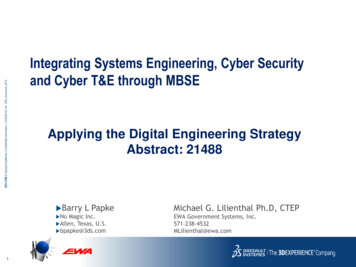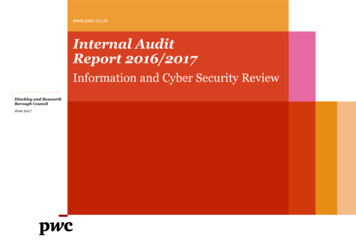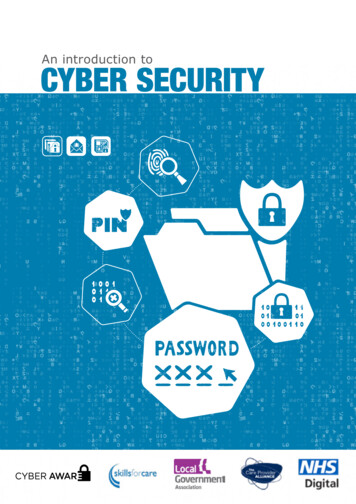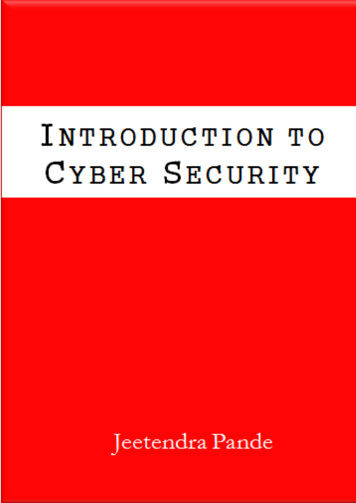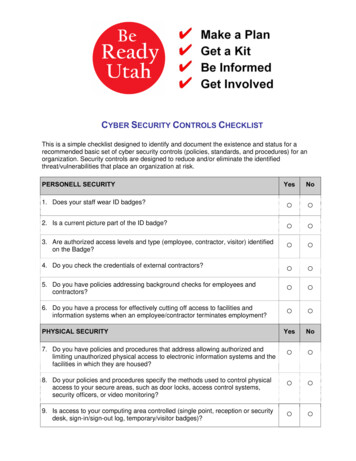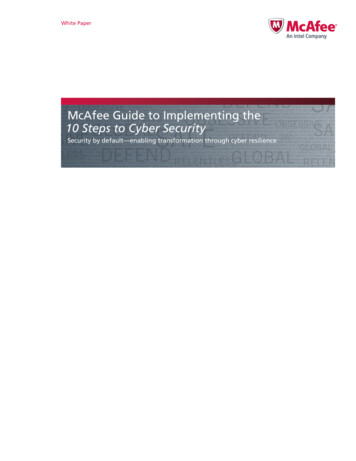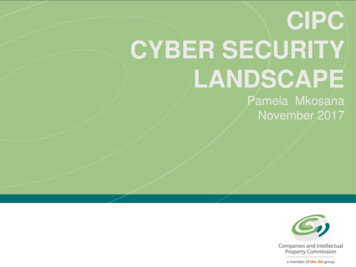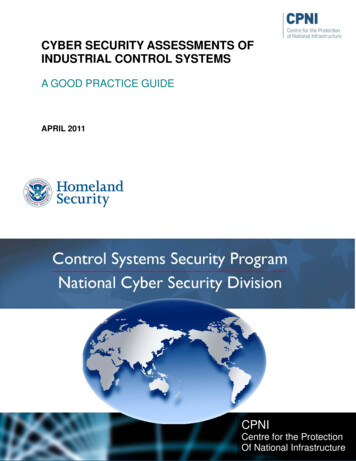
Transcription
October 2010CYBER SECURITY ASSESSMENTS OFINDUSTRIAL CONTROL SYSTEMSA GOOD PRACTICE GUIDEAPRIL 2011CPNICentre for the ProtectionOf National Infrastructure
CYBER SECURITY ASSESSMENTS OF INDUSTRIAL CONTROL SYSTEMSA GOOD PRACTICE GUIDEExecutive summaryCyber security has become a vital part of conducting business in today’s world. The threatsto organisations and individuals are real. Industrial Control Systems (ICSs) were originallybuilt as stand-alone systems which were not interconnected and had little in the way ofsecurity protections. The internet and ubiquitous internet protocol networks have changed thedesign of many ICS such that the control network is now often a protected extension of thecorporate network. This means that these delicate ICSs are potentially reachable from theinternet by malicious and skilled adversaries.One tool that an ICS asset owner may use to assess the risk to the ICS is to procure andfacilitate a cyber security assessment. The ICS cyber security assessment identifies andseeks to mitigate vulnerabilities that would allow an attacker to disrupt or take control of thesystem. Many considerations have to be taken into account because of significantdifferences between an ICS cyber security assessment and the tests that would beperformed in a standard corporate environment. For example, several tools employed in sucha test could have a serious impact on the ICS itself. Various ICSs will malfunction or haltcompletely when security tools, such as scanners, are run on the network. Therefore, theasset owner and assessment team must understand the potential implications of testing on aproduction system. Whenever possible, cyber security tests should be performed on abackup or offline ICS.This guide aims to assists asset owners to maximise the return on their investment whencommissioning assessments of their ICSs.The guide provides an overview of the assessment process so users understand how toexecute an ICS cyber security assessment. This guide also covers the process of planningan ICS cyber security assessment, including how to select testing areas. The test planspecifies the correct amount of detail to meet the needs of the asset owner while retainingthe flexibility to use all the skills of the assessment team. The details of the actual testingprocess in this guide familiarise the asset owner with the steps and reasons behind thetesting process. The reporting process for an ICS cyber security assessment is also coveredin this guide.In addition to explaining actual security testing, the pros and cons of a number of alternatevulnerability testing methods for ICSs are also considered so tests can be tailored to thespecifics of the ICS and needs of the organisation.The best assessment methodology is the one that promises the highest vulnerabilityreduction at lowest cost. The benefit from a vulnerability assessment is proportional to thenumber of vulnerabilities that are identified for remediation. The actual benefit is thedecreased risk due to vulnerability remediation. The benefit is therefore dependent on theasset owner’s ability to mitigate the identified vulnerabilities. The asset owner should ensurethat the assessment team provides adequate vulnerability details and mitigation informationfor the ICS administrators or vendors to efficiently and effectively remediate each securityweakness. Collaboration between assessment and ICS personnel throughout theassessment allows knowledge transfer both directions and efficient assessment andmitigation performance. ICS staff can gain security knowledge directly applicable to theirsystem and mitigate vulnerabilities as they are identified.1
CYBER SECURITY ASSESSMENTS OF INDUSTRIAL CONTROL SYSTEMSA GOOD PRACTICE GUIDEContentsDisclaimers .4ICS Assessment versus a typical IT penetration test .5Types of cyber security testing.5Levels of disclosure .7Focus of testing.8Impacts of testing.9Testing process overview. 11Overview . 11Choosing the assessment team.14The test plan .15Selecting the attack vectors .15Assessment execution .19Assessment reporting .25Vulnerability mitigation and vendor engagement .36Assessment variables.37Alternative methodologies .39Laboratory assessment.39Production system .42End-to-end penetration assessment .44Component testing.46Technical documentation review .47Functionality and configuration review.50Staff interviews.52Risk assessment.53Assessment methodologies conclusion .55Conclusion .59Glossary .63Acronyms .63Nomenclature.652
CYBER SECURITY ASSESSMENTS OF INDUSTRIAL CONTROL SYSTEMSA GOOD PRACTICE GUIDEOverviewThis guide has been prepared to assist asset owners in procuring and executing cybersecurity tests of their Industrial Control, Supervisory Control and Data Acquisition (SCADA),Distributed Control (DCS) and/or process control (PCS) systems, hereafter genericallyreferred to as an industrial control system (ICS). The guide’s purpose is to educate assetowners on the general process of a cyber security test and provide insight on specific testingmethods so owners learn to prescribe a custom assessment that will maximise the output oftheir testing budget.This guide also doubles as a checklist for internal teams performing cyber securityassessments to ensure their plans cover the high-risk areas of an ICS. It lists some possibletesting methods and describes pros and cons for each method based on the cyber securityICS testing experience of Idaho National Laboratory (INL). Asset owners are able to applythis information in the decision-making process for planning an ICS assessment.This guide does not describe how to execute specific cyber security tests; rather, it focuseson what should be covered in an ICS cyber security assessment. General cyber securityguidance can be followed to meet the operational and security goals of individual ICScomponents, but like other computer networks, the security goals, threats and potentialimpacts vary between systems. For this reason, cyber security guidance cannot becomeprescriptive. Security standards and best practices must be used as guidelines, tailored tothe individual system’s requirements. Although the ICS domain has many traits in commonwith the corporate IT domain, the security goals and potential consequences of an attack arevery different. This document focuses on the security goals and risks common to the ICSdomain and how it interacts with the rest of the network.The authors prepared this guide under the assumption that the reader has a generalunderstanding of ICSs. For this reason, the guide does not cover best practice topics on theway that ICSs are designed and used.3
CYBER SECURITY ASSESSMENTS OF INDUSTRIAL CONTROL SYSTEMSA GOOD PRACTICE GUIDEDisclaimersA secure ICS does not exist, which means that hidden vulnerabilities are still possible in anICS, even after a clean report from a cyber security assessment. Cyber security should beperceived as a process rather than a project. A cyber security assessment of an ICS isviewed as a snapshot in time. An ICS needs to be iteratively tested, based on triggers suchas changes to the system or an elapsed period of time. One reason for repeated testing isthat most ICSs are built using commercial off-the-shelf hardware and software. Newvulnerabilities often are discovered in the current operating systems and third-party softwarewhich make up today’s ICSs. The implications of these vulnerabilities to the ICS domain maynot be obvious, but could be exposed by a cyber security assessment. Also, one assessmentteam may have skills or ideas that uncover problems that another team missed in previoustests. New exploit and mitigation techniques are continually developed, so additional findingsand mitigation recommendations should be expected from subsequent vulnerabilityassessments.This guide considers several cyber security tools and software programs. These referencesserve as examples rather than endorsements. For every tool referenced, other proprietaryand open source alternatives may exist which implement the same features with varyinglevels of effectiveness.Cyber security testing activities may have adverse effects on any target system, butespecially on an ICS. Cyber security tests often employ port and vulnerability scanners thatmake rapid requests to an Internet Protocol (IP) address, often with invalid data. Thesescans alone often cause a victim process or entire machine to fail. When the target is anactive ICS server, this failure could have serious and drastic consequences. All cybersecurity testing should be well planned and communicated with the equipment owners andoperators so that potential faults are resolved or mitigated. The testing methods presented inthis document are, therefore, to be employed at the asset owner’s own risk.To the fullest extent permitted by law, CPNI accepts no liability for any loss or damage(whether direct, indirect or consequential and including, but not limited to, loss of profits oranticipated profits, loss of data, business or goodwill) incurred by any person and howsoevercaused arising from or connected with any error or omission in this document or from anyperson acting, omitting to act or refraining from acting upon, or otherwise using, theinformation contained in this document or its references. You should make your ownjudgement as regards use of this document and seek independent professional advice onyour particular circumstances.4
CYBER SECURITY ASSESSMENTS OF INDUSTRIAL CONTROL SYSTEMSA GOOD PRACTICE GUIDEICS Assessment versus a typical IT penetration testAlthough similarities exist in the tools and methodologies used, an ICS cyber securityassessment differs significantly from an IT penetration test. Some of these differencesconcern the goals, focus and impact of testing.Types of cyber security testingThe goals of testing can generally be described as assessing the level of security and/oridentifying vulnerabilities for remediation/mitigation. Vulnerabilities can be identified byattacking the system as a hacker would or by evaluating the system.A vulnerability assessment simply identifies and reports noted vulnerabilities and securityweaknesses in the target system. The assessment team generally reviews code, settings,etc. for known security weaknesses. Many security tools and techniques used by penetrationtesters and hackers are used to help identify and validate vulnerabilities. The customer mayspecify the level of vulnerability verification. For example, practices known to lead tovulnerabilities can be identified for remediation to decrease assessment costs, increasevulnerability identification coverage, and maximise the security of the system.A penetration test attempts to duplicate the actions of an attacker. The goal of externalpenetration testing is to find weaknesses in the company’s network that could allow anattacker to access the enterprise environment from the internet. Internal testing attempts tofind and exploit vulnerabilities to determine whether unauthorised access or other maliciousactivity is possible from inside the target network.aThis can gi
design of many ICS such that the control network is now often a protected extension of the corporate network. This means that these delicate ICSs are potentially reachable from the internet by malicious and skilled adversaries. One tool that an ICS asset owner may use to assess the risk to the ICS is to procure and facilitate a cyber security assessment. The ICS cyber security assessment .

